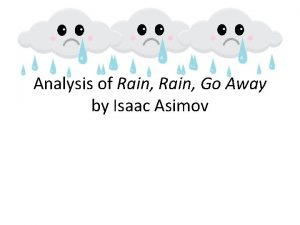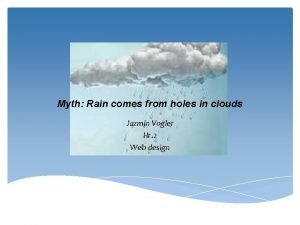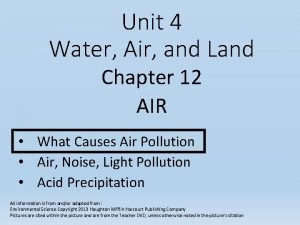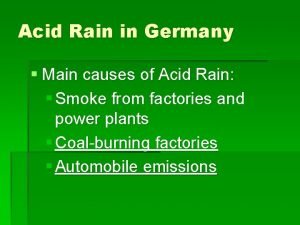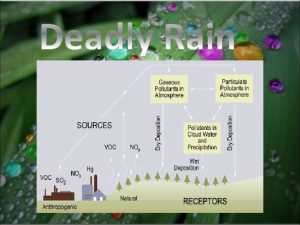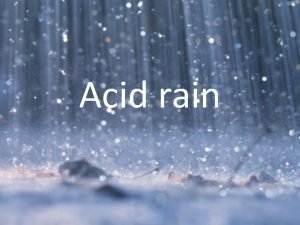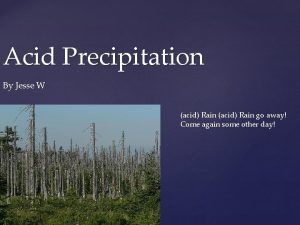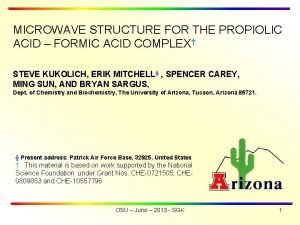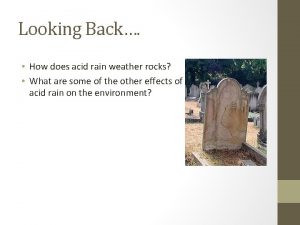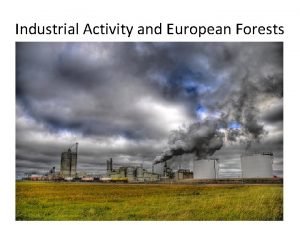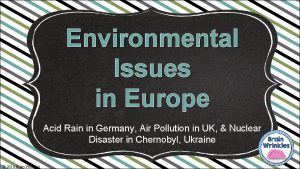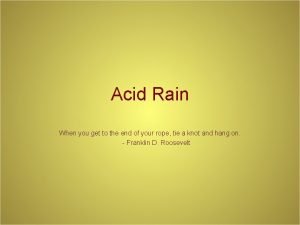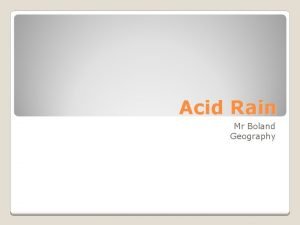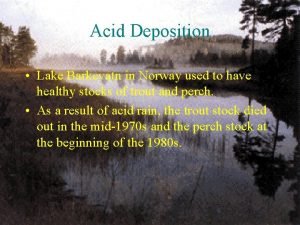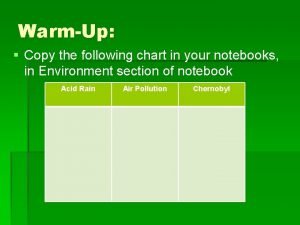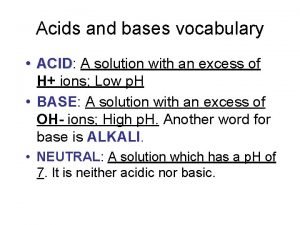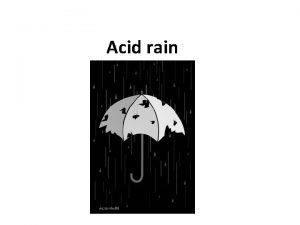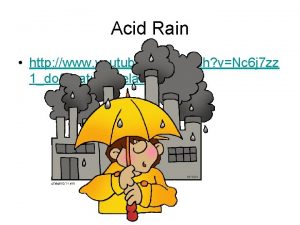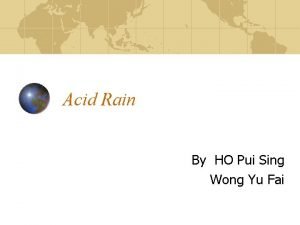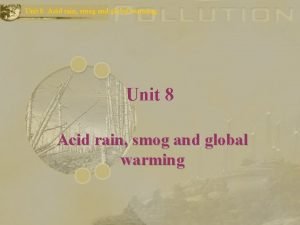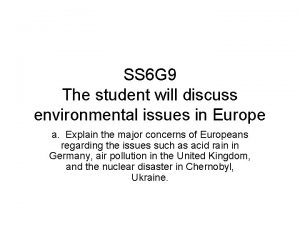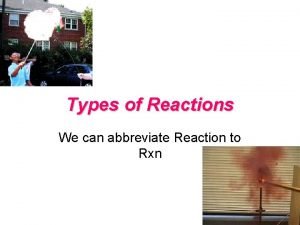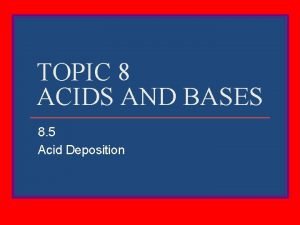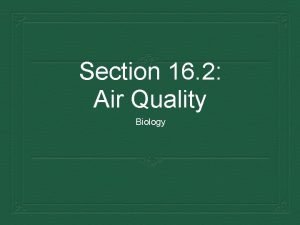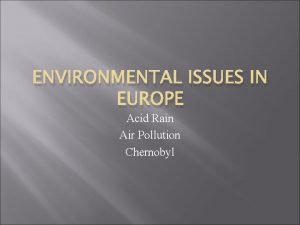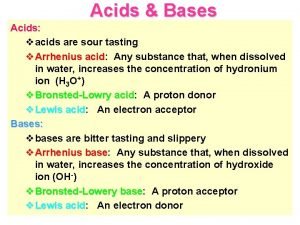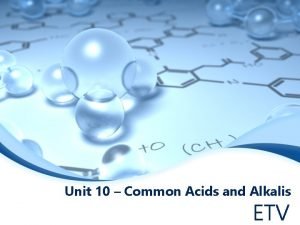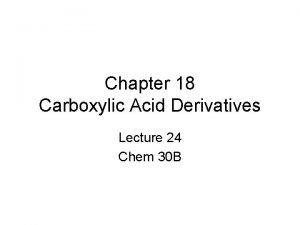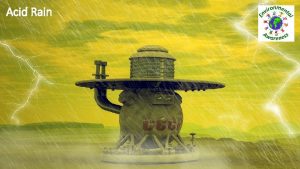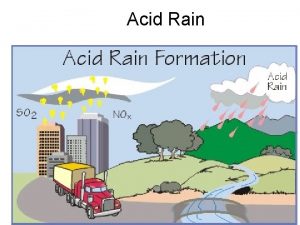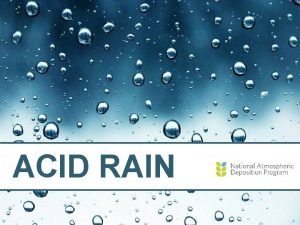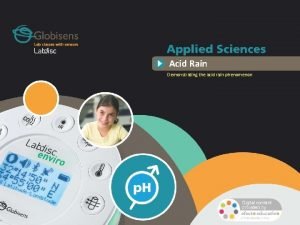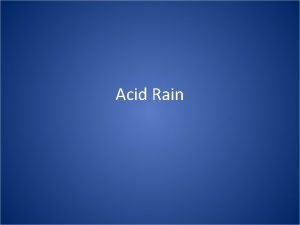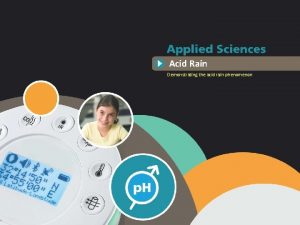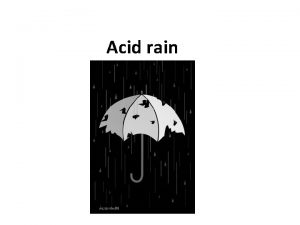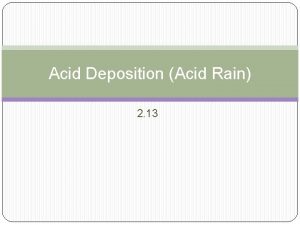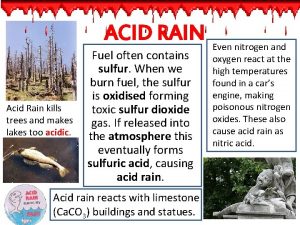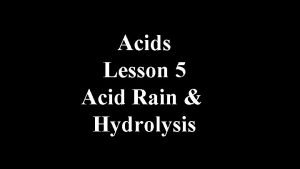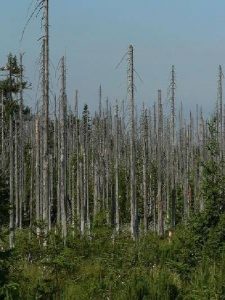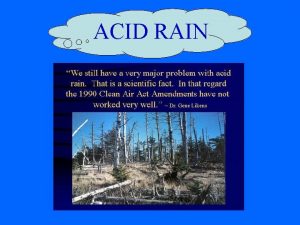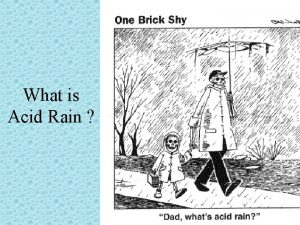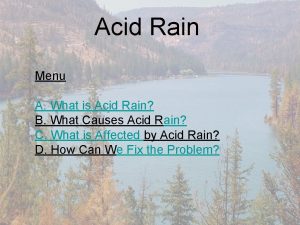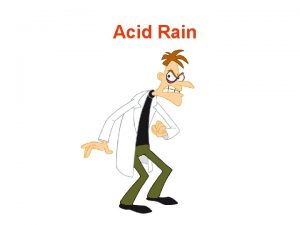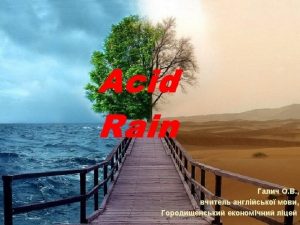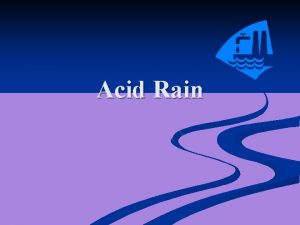Clouds and Acid Rain General considerations on clouds












































- Slides: 44

Clouds and Acid Rain • • General considerations on clouds and fogs Aqueous-phase chemistry Aqueous-phase chemical transformations Emission control strategies for acid rain

Clouds Cloud top: evaporation Ascending air motion Cloud base: start of water vapor condensation A cloud is formed when water vapor condenses on ultrafine particles (Aitken nuclei) and fine particles, and next on cloud droplets and ice crystals. Condensation occurs when the ascending air parcel cools adiabatically, which leads to a lower capacity to contain water vapor (i. e. , increase in relative humidity): cloud base. When temperature and pressure are such that the relative humidity becomes less than 100 %, the cloud evaporates (cloud top). Therefore, there is constant air motion within a cloud.

Cumulus Clouds Cumulus clouds are formed in presence of a strong vertical air motion (convection).

Stratus Clouds Stratus clouds are formed when a moist air parcel rises and, while colling adiabatically, leads to the condensation of water vapor (since cold air has a lower capacity for water vapor content than warm air).

Precipitating Clouds: Nimbus Cumulonimbus and Nimbostratus When cloud droplets increase in size, their fall velocity increases. If the cloud droplet fall velocity becomes greater than the vertical velocity of the ascending air parcel, the cloud droplet becomes a rain drop. - A precipitating cumulus cloud is called a cumulonimbus. - A precipitating stratus cloud is called a nimbostratus.

Precipitating and Non-precipitating Clouds Non-precipitating cumulus cloud Precipitating cumulonimbus

Precipitating and Non-precipitating Clouds vs, r Non-precipitating cumulus cloud w The fall velocity of the cloud droplets, vs, r, is less than the vertical velocity of the ascending air, w.

Precipitating and Non-precipitating Clouds vs, r w The fall velocity of the cloud droplets (raindrops), vs, r, is greater than the vertical velocity of the ascending air, w. Precipitating cumulonimbus

Fogs Fog is a cloud that is in contact with the Earth’s surface (visual range < 1 km) Advection fog Radiation fog

Fogs An advection fog forms when a moist air parcel gets into contact with a cold surface, which leads to a decrease in the saturation vapor pressure of water vapor and its condensation (for example, summer fog in San Francisco, California, due to the upwelling coastal cold water of the Pacific Ocean). Advection fog

Fogs A radiation fog forms when the ambient temperature of a moist air parcel decreases sufficiently (for example at night), thereby leading to a decrease in the saturation vapor pressure of water vapor such that it reaches 100 % relative humidity (for example wintertime fogs in humid areas). Radiation fog

Clouds and Fogs • Liquid water contents (order of magnitude) – Cumulus: ~ 1 g/m 3 – Cumulonimbus: > 1 g/m 3 – Stratus: ~ 0. 1 g/m 3 – Nimbostratus: > 0. 1 g/m 3 – Fog: < 0. 1 g/m 3 • Drops and droplets (order of magnitude of the mean diameter) – Non-precipitating cloud: ~ 40 mm – Rain: ~ 1 mm – Fog: ~ 10 mm

Atmospheric Particles • Some particles (or fractions of particles) are formed by chemical reaction in the atmosphere from gases (sulfate, nitrate, ammonium, organic compounds…); these reactions can occur in the gas phase or in the aqueous phase: these are secondary particles or secondary PM. • If the cloud evaporates, then some of the droplet chemical species form an atmospheric particle.

Nitric Acid Formation Heterogeneous reactions in clouds NO 3 + H 2 O => HNO 3 + OH NO 2 + O 3 => NO 3 + O 2 NO 2 + OH => HNO 3 NOx NO 3 + NO 2 <=> N 2 O 5 + H 2 O => 2 HNO 3

Nitric Acid Formation Daytime Gas Phase: OH NO 2 + OH => HNO 3 These reactions are negligible at night because OH is not produced in the absence of sunlight (with the exceptions of alkene oxidation by O 3 and PAN reaction in presence of very high NO concentrations). This reaction is not linear for NO 2 => HNO 3 A change of x % in NO 2 leads to a change in OH radical concentrations, which affects the reaction rate and, therefore, a change in nitric acid, which is not exactly x %. k = 13600 ppm-1 min-1; vr = k [NO 2] [OH] > 106 cm-3 => the oxidation rate of NO 2 is on the order of 10 % per hour during a summer day.

Nitric Acid Formation Nighttime Gas Phase: O 3 NO 2 + O 3 => NO 3 + O 2 NO 3 + H 2 O => HNO 3 + OH NO 2 + NO 3 <=> N 2 O 5 N 2 O 5 + H 2 O => 2 HNO 3 These reactions are negligible during the day because NO 3 is rapidly photolyzed: NO 3 + hn => NO 2 + O ; NO 3 + hn => NO + O 2 The hydrolysis reactions (NO 3 + H 2 O and N 2 O 5 + H 2 O) are much faster when they occur heterogeneously at the surface of droplets.

Nitric Acid Formation Nighttime Gas Phase: O 3 NO 2 + O 3 => NO 3 + O 2 NO 3 + H 2 O => HNO 3 + OH NO 2 + NO 3 <=> N 2 O 5 N 2 O 5 + H 2 O => 2 HNO 3 This system of reactions is strongly non-linear for NO 2 => HNO 3 A change of x % in NO 2 leads to a change in O 3 concentrations, which affects the rate of the first reaction and, therefore, leads to a change in nitric acid, which is not exactly x % (it can be greater or less than x).

Nitric Acid Formation Gas phase: Organic Compounds NO 3 + RH => HNO 3 + R These reactions are generally minor for the formation of HNO 3.

Sulfuric Acid Formation System of non-linear reactions in clouds SO 2 + OH => H 2 SO 4 + HO 2 SO 2 H 2 O 2 + O 3 O 2 => H 2 SO 4

Sulfuric Acid Formation Gas Phase: OH SO 2 + OH + M => HOSO 2 + M HOSO 2 + O 2 => SO 3 + HO 2 SO 3 + H 2 O + M => H 2 SO 4 + M ______________ SO 2 + OH => H 2 SO 4 + HO 2 + NO => OH + NO 2 This system of reaction is linear for SO 2 => H 2 SO 4 A change of x % in SO 2 leads to a change of x % in sulfuric acid.

Sulfuric Acid Formation Gas Phase: OH SO 2 + OH + M => HOSO 2 + M HOSO 2 + O 2 => SO 3 + HO 2 SO 3 + H 2 O + M => H 2 SO 4 + M ______________ SO 2 + OH => H 2 SO 4 + HO 2 The first reaction governs the overall reaction rate because the following reactions are much faster. Therefore, the overall kinetics is governed by the rate of the first reaction: k = 1400 ppm-1 min-1 ; vr = k [SO 2] [OH] > 106 cm-3 => the oxidation rate of SO 2 is on the order of 1 % per hour during a summer day.

Atmospheric Aqueous Phase Concentration and Activity Concentration of a chemical species in the aqueous phase: - Molar fraction: number of moles per mole of water (xi) - Molality: number of moles per kg of water (mi) - Molarity: number of moles per liter of water (ci) Therefore, for trace pollutants: mi ~ ci Activity of a chemical species in a non-ideal solution: a i = gi x i where: xi = molar fraction ai = activity gi = activity coefficient; it represents the deviation of the solution with respect to an ideal solution.

Atmospheric Aqueous Phase Concentration and Activity of a chemical species in a non-ideal solution: a i = gi x i For a cloud droplet, one may assume that the solution is ideal because the concentrations of chemical species (other than water) are small: gi = 1 and ai = xi However, for a small particle, the solution will not be ideal because the concentrations of chemical species will be high.

Atmospheric Aqueous Phase Equilibrium with the Gas Phase A(g) <=> A(aq) Henry’s law (dilute solution): [A(aq)] = HA PA [A(aq)]: molarity of A (moles per liter or M) PA: partial pressure of A (atm) HA: Henry’s law constant (M atm-1) Important points: - The Henry’s law constant can be defined with other units and is sometimes defined as the inverse ratio (concentration in the gas phase / concentration in the aqueous phase). - Henry’s law is valid only for species present in low concentrations.

Effective Henry’s Law Constant Monoacid: HNO 3 Gas/water equilibrium HNO 3(g) <=> HNO 3(aq) Dissociation equilibrium HNO 3(aq) <=> NO 3 - + H+ Equilibrium constants: [HNO 3(aq)] = HHNO 3 PHNO 3 [NO 3 -] [H+] / [HNO 3(aq)] = KHNO 3 [HNO 3(aq)], [NO 3 -], [H+]: molarities (M) PHNO 3: partial pressure of NO 3 (atm) HHNO 3: Henry’s law constant (M atm-1) KHNO 3: dissociation constant of acid HNO 3 (M)

Effective Henry’s Law Constant Monoacid: HNO 3 One defines the effective Henry’s law constant, HHNO 3, eff, as the equilibrium between the species in the gas phase and all corresponding species in the aqueous phase: [HNO 3(aq)] + [NO 3 -] = HHNO 3, eff PHNO 3 Substituting: [HNO 3(aq)] + ([HNO 3(aq] KHNO 3 / [H+]) = HHNO 3, eff PHNO 3 [HNO 3(aq)] (1 + KHNO 3 / [H+]) = HHNO 3, eff PHNO 3 HHNO 3, eff = HHNO 3 (1 + KHNO 3 / [H+])

Effective Henry’s Law Constant Diacid: Sulfuric Acid (H 2 SO 4) This equation can be generalized in the case of a second dissociation (for diacids such as sulfuric acid). Gas/water equilibrium H 2 SO 4(g) <=> H 2 SO 4(aq) Dissociation equilibria H 2 SO 4(aq) <=> HSO 4 - + H+ HSO 4 -(aq) <=> SO 42 - + H+ K 1 K 2 Effective Henry’s law constant: HH 2 SO 4, eff = HH 2 SO 4 (1 + (K 1 / [H+]) + (K 1 K 2 / ([H+]2))

Effective Henry’s Law Constants Bases and Acids One can also define effective Henry’s law constants for bases (for example, for ammonia, NH 3). The effective Henry’s law constant depends on p. H. For an acid, it decreases as the p. H decreases (less dissociation of acids in an acidic solution). For a base, it increases as the p. H decreases (more dissociation of bases in an acidic solution).

Solubility of some Air Pollutants H < 103 M atm-1 not soluble 103 < H < 105 soluble (a) p. H = 5. 6; LWC = 1 g/m 3; T = 25 °C; (b) including diol formation H > 105 very soluble

Dissociation Equilibrium of Water H+ is the hydrogen ion (proton); OH- is the hydroxide ion p. H = 7. 0 for pure water at 298 K

Atmospheric Aqueous Phase CO 2(g) <=> CO 2(aq) H = 3. 4 x 10 -2 M atm-1 CO 2(aq) + H 2 O(l) <=> H 2 CO 3 <=> HCO 3 - + H+ K = 4. 3 x 10 -7 M HCO 3 - <=> CO 32 - + H+ K = 4. 7 x 10 -11 M H 2 O <=> H+ + OH- K = 10 -14 M 2 Electroneutrality equation of the aqueous phase: [H+] = [HCO 3 -] + 2 [CO 32 -] + [OH-]

Atmospheric Aqueous Phase The concentration of carbon dioxide is currently about 400 ppm The p. H of water in clouds can be calculated from the atmospheric concentration of CO 2: it it about 5. 6.

Dissolution of SO 2 in the Aqueous Phase SO 2(g) <=> SO 2(aq) H = 1. 23 M atm-1 SO 2(aq) + H 2 O(l) <=> H 2 SO 3 <=> HSO 3 - + H+ K 1 = 1. 3 x 10 -2 M HSO 3 - <=> SO 32 - + H+ K 2 = 6. 6 x 10 -8 M SO 2 is a weak acid: it is not completely dissociated in the aqueous phase [S(IV)] = [H 2 SO 3] + [HSO 3 - ] +[SO 32 - ]

Dissolution of SO 2 in the Aqueous Phase

Dissolution of SO 2 in the Aqueous Phase Range of p. H values in atmospheric clouds: HSO 3 - is the major species

Dissolution of H 2 SO 4 in the Aqueous Phase H 2 SO 4 <=> HSO 4 - + H+ HSO 4 - <=> SO 42 - + H+ H 2 SO 4 is a strong acid: it dissociates easily in the aqueous phase. [S(VI)] = [H 2 SO 4] + [HSO 4 - ] +[SO 42 - ]

Sulfuric Acid Formation Aqueous Phase: H 2 O 2 HSO 3 - + H 2 O 2 => HSO 4 - + H 2 O This reaction does not depend much on p. H. The rate of this reaction is fast and the lifetime of SO 2 is on the order of only a few minutes: it is a titration reaction. H = 7. 4 x 104 M / atm for H 2 O 2 M s-1

Sulfuric Acid Formation Aqueous Phase: H 2 O 2 SO 2 + H 2 O 2 => H 2 SO 4 If [SO 2] < [H 2 O 2]: a change of x % in SO 2 leads to a change of x % in sulfuric acid and the system is linear. If [SO 2] > [H 2 O 2]: a change of x % in SO 2 leads to a change of 0 % in sulfuric acid as long as [SO 2] > [H 2 O 2] and the system is non-linear; the reaction stops when H 2 O 2 has been totally consumed: one says that the system is oxidant-limited.

Sulfuric Acid Formation Aqueous Phase: O 3 H 2 SO 3 + O 3 => H 2 SO 4 + O 2 k = 2. 4 x 104 M-1 s -1 HSO 3 - + O 3 => HSO 4 - + O 2 k = 3. 7 x 105 M-1 s -1 SO 32 - + O 3 => SO 42 - + O 2 ______________ S(IV) + O 3 => S(VI) k = 1. 5 x 109 M-1 s -1 HO 3 = 1. 1 x 10 -2 M/atm This reaction depends strongly on p. H. The overall reaction rate is fast but the lifetime of SO 2 is on the order of several tens of minutes; therefore, it is typically slower that the oxidation by H 2 O 2.

Sulfuric Acid Formation Aqueous Phase: O 3 SO 2 + O 3 => H 2 SO 4 When H 2 SO 4 is formed, the p. H decreases (more acidic solution), the rate slows down and H 2 SO 4 formation decreases => this reaction is self-limiting. Therefore, a decrease of x % in SO 2 does not lead to a change of x % in sulfuric acid, but to a lesser decrease.

Sulfuric Acid Formation Aqueous Phase: O 2 S(IV) (+ Mn 2+, Fe 3+) => S(VI) This reaction is catalyzed by metal ions such as Fe 3+ and Mn 2+. The overall reaction rate is fast only when p. H > 4; the kinetics slows down when the p. H decreases and, therefore, this reaction is self-limiting. Therefore, a decrease of x % in SO 2 does not lead to a change of x % in sulfuric acid, but to a lesser decrease.

Aqueous-phase Chemistry Kinetics of SO 2 Oxidation Conditions for the cloud aqueous phase are as follows: the cloud is at about 3 km altitude, P = 0. 69 atm, T = 5 °C, L = 0. 5 g m-3. Conditions for the gas phase are as follows: P = 1 atm, T = 25 °C, clear sky. Concentrations are as follows: [SO 2(g)] = 2 ppb, [H 2 O 2(g)] = 2 ppb, [O 3(g)] = 40 ppb, [Fe(aq)] = 10 m. M, [Mn(aq)] = 0, 5 m. M, [OH(g)] = 106 cm-3.

Aqueous-phase Chemistry Kinetics of SO 2 Oxidation • In an acidic solution, oxidation by H 2 O 2 is the only important oxidation pathway. • Oxidation by ozone and oxygen is self-limiting because the formation of sulfuric acid leads to a decrease in p. H and, therefore, the kinetics slows down. • Gas-phase oxidation by OH is very slow.

Emission Control Strategies for Acid Rain • Acid rain is due mostly to sulfuric acid (H 2 SO 4) and nitric acid (HNO 3). • The formation of H 2 SO 4 is dominated by aqueous-phase chemistry because its gas-phase chemistry is slow. The reduction of SO 2, precursor of H 2 SO 4, may be strongly non-linear if the SO 2 concentrations are greater than the H 2 O 2 concentrations (i. e. , in an oxidant-limited regime). It will be almost linear once the SO 2 concentrations become less than the H 2 O 2 concentrations (some nonlinearity remains due to the p. H dependency of the O 3 and O 2 reactions). • The reduction of the precursors of HNO 3 may lead to a non-linear response of nitric acid formation, because it also affects oxidant concentrations (via the VOC/NOx ratio of photochemical smog formation).
 Low-lying clouds that produce rain and snow
Low-lying clouds that produce rain and snow General consideration of machine design
General consideration of machine design Rain, rain, go away by isaac asimov summary
Rain, rain, go away by isaac asimov summary The man to send rain clouds characters
The man to send rain clouds characters The man to send rain clouds symbolism
The man to send rain clouds symbolism Where rain comes from
Where rain comes from Statue of liberty before and after acid rain
Statue of liberty before and after acid rain Before and after acid rain
Before and after acid rain Coal and acid rain
Coal and acid rain Acid rain causes
Acid rain causes Acid rain chemical reaction
Acid rain chemical reaction Triangle
Triangle Acid rain in canada
Acid rain in canada Rainoutcomes
Rainoutcomes Acid rain pathway
Acid rain pathway Acid rain facts
Acid rain facts Osu
Osu How does acid rain weather rocks
How does acid rain weather rocks Industrial activity
Industrial activity Which rock weathers most rapidly when exposed to acid rain?
Which rock weathers most rapidly when exposed to acid rain? Acid rain remedies
Acid rain remedies Acid rain in germany illustration
Acid rain in germany illustration Acid rain in europe
Acid rain in europe Acid rain
Acid rain Acid rain reaction
Acid rain reaction Copy and complete the following chart
Copy and complete the following chart Acid vocabulary
Acid vocabulary Acid rain
Acid rain Acidic rain
Acidic rain Lord acid rain
Lord acid rain Smog
Smog Acid rain
Acid rain Acid rain calcium carbonate
Acid rain calcium carbonate Prevention of acid rain
Prevention of acid rain Acid rain map
Acid rain map Objectives of acid rain
Objectives of acid rain Acid rain chernobyl
Acid rain chernobyl Acid fast and non acid fast bacteria
Acid fast and non acid fast bacteria Non acid fast bacteria
Non acid fast bacteria Writing strategies and ethical considerations
Writing strategies and ethical considerations Ethical consideration in experimental research sample
Ethical consideration in experimental research sample Pricing considerations and approaches
Pricing considerations and approaches Acid base reaction general equation
Acid base reaction general equation 9-which acid is not considered a strong acid?
9-which acid is not considered a strong acid? Imides
Imides


